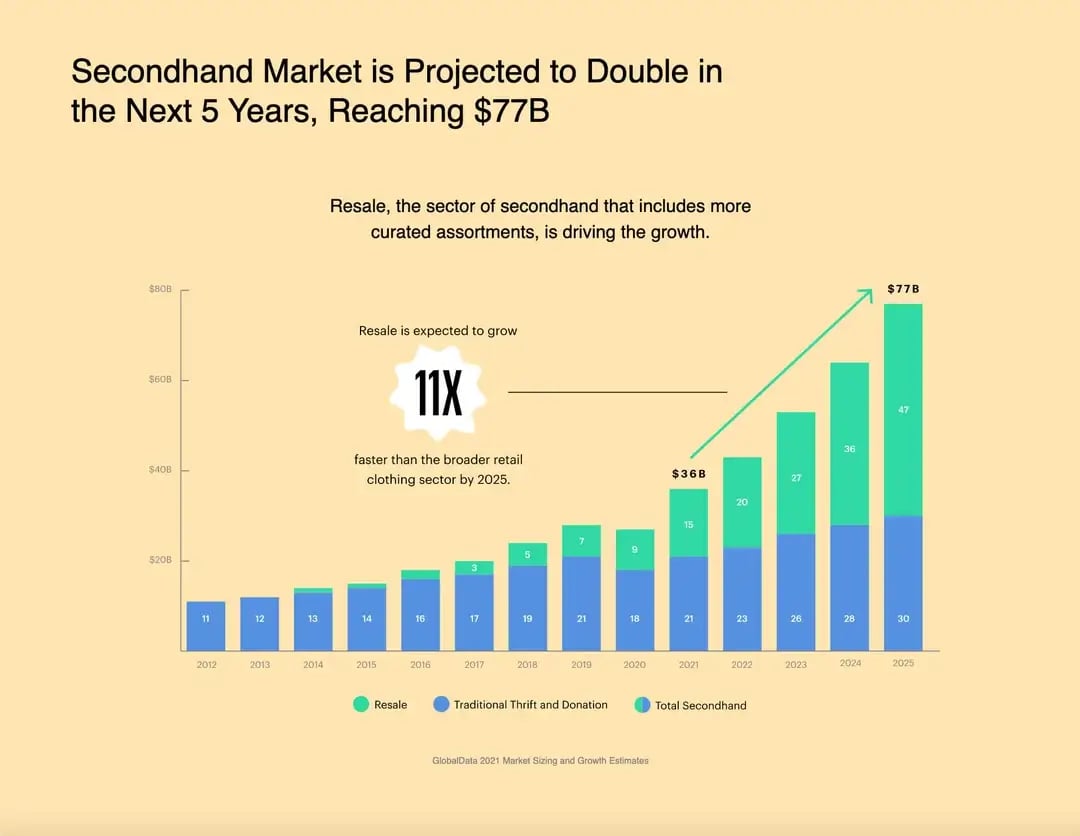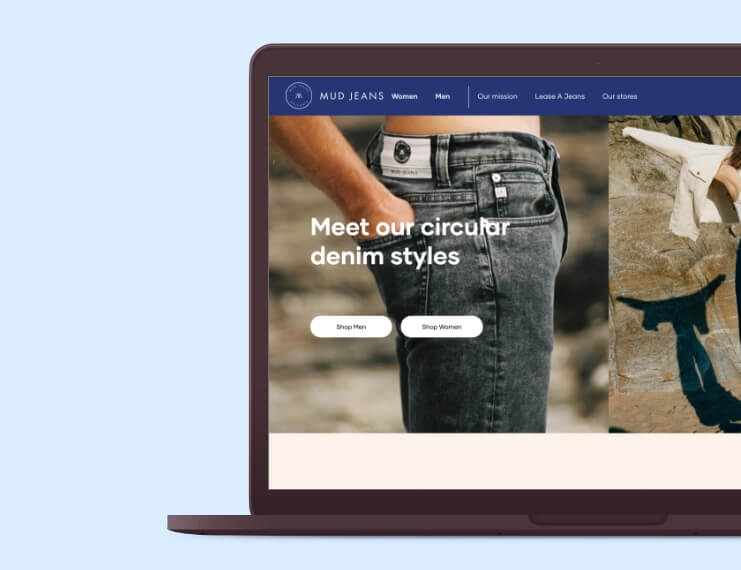So it’s no surprise that large retailers are now working on facilitating resale and integrating it into their existing business models to bump their revenue stream.
IKEA is testing its resale platform in the US, Zalando uses outdoor ad campaigns to promote its resale endeavors and H&M joined forces with Selly to set up a resale platform. Even Gucci is now offering resale and sees it as an opportunity to attract new (mostly young Gen-Z) clientele. Now it may seem as if this strategy is only suited for the big brands, but that couldn’t be further from the truth. Especially now that the technical solutions that make resale possible are also available to smaller businesses, it’s achievable for every brand to integrate resale into their business model.
98% of consumers feel that brands are responsible for initiating positive change.
But why this change of heart?
There’s a couple of reasons for brands to target the resale market right now. First of all, you’ve probably noticed that there’s a lot of second-hand trade going on. Platforms such as Vinted and The Next Closet are growing rapidly, both in popularity and volume. Second-hand Facebook groups and trading through Marktplaats are also very popular.
In addition, consumer needs are shifting. They still want to buy items for a sharp price, but they also want to reuse products and, with that, reduce waste and emissions. Resale meets all those demands. MUD Jeans clients, for example, receive a discount when they return their old jeans, which then get recycled to prevent the sustainable raw materials from ending up in a landfill. Denham offers repairs to extend the lifetime (and sustainability) of their products. For these brands, resale is a way of building a long-term relationship with their customers while reviving their brand’s ethical value at the same time.
The difference in environmental impact for a used or new product is massive. For a second-hand product, the carbon footprint is a whopping 82% smaller.
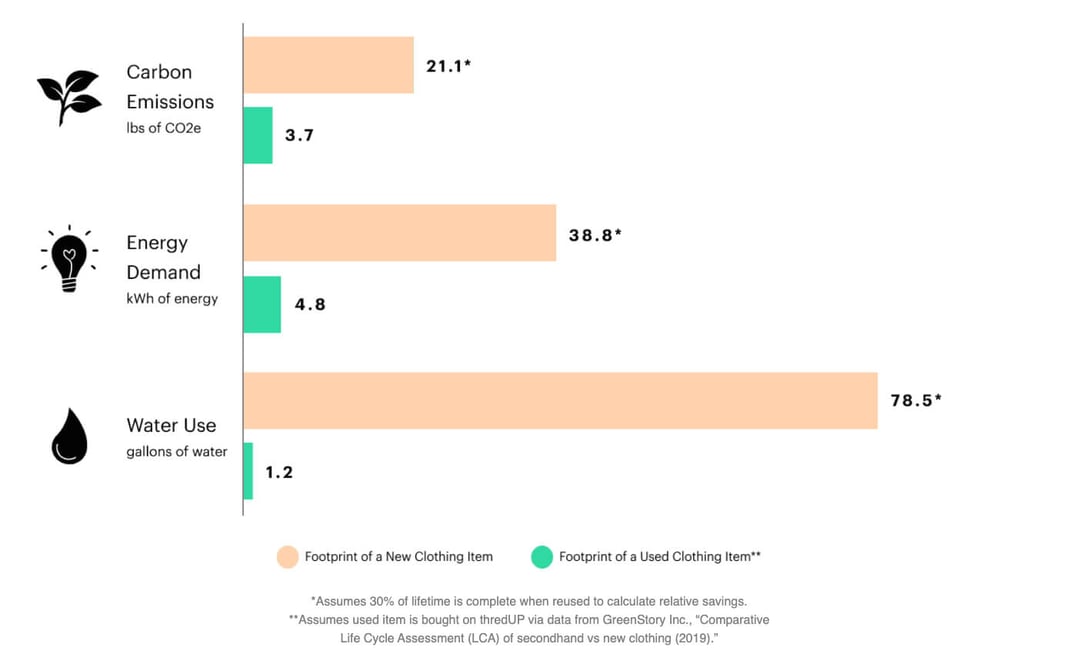
Does resale fit into my brand strategy?
Choosing resale is generally part of a brand’s sustainability strategy, but can also be used to extend the CLV (customer lifetime value) and increase the purchase frequency. You can imagine how customers would like to sell their old bag, ottoman, shoes or dress to buy something new with the proceeds, a type of trade-in discount we know from the automobile industry. Or customers switched sizes and are looking to sell their L to buy an M instead. The customer data that you collect here is very valuable when communicating with your customer (segment). Which you can then use for perfecting your online marketing. Win-win!
To determine whether or not reselling your product is going to be worth your while, you can start by looking if people are already selling your products on the popular marketplaces.
Is your product being offered second-hand on Vinted, Marktplaats or in a Facebook group? If so, this presents an opportunity to pull the accompanying data and cash flow into your own portal and to connect with the customer.
How to get started and what business model should I use? (Fashion and interior) consumers are used to buying something new regularly and often use second-hand options, both for buying and selling. In addition, multiple studies show that especially Gen Z values resale products that are both more sustainable and cheaper.
There are a couple of business models that you can use as part of your sustainability strategy:
- Peer-to-peer: you connect the buyer and the seller
- Own or existing resale platform: you build and manage your own platform (with or without a partner).
- Buy-Back: you, or a third party, buy back the product. This is a financial risk, as you’re not sure whether you will sell the bought-back item again.
- Consignment: you, or a third party, buy back the product and take care of all the handling. The transaction is only settled when the product is actually sold again.
The last two models are more common for luxury brands.
Once you’ve chosen a business model that suits you, the time has come to choose whether you’re going to set up a resale process yourself, have someone else do it for you, use a software solution or involve a partner. The most important reason for involving a partner is that they can take care of the handling of buying items back, repairing and shipping them. Easy peasy!
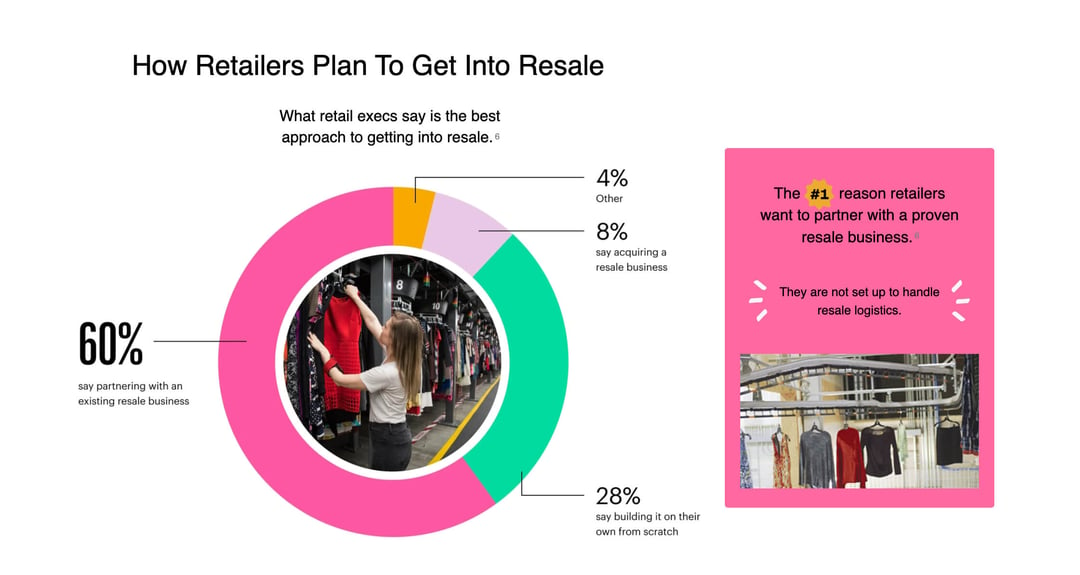
1. Peer-to-peer
The peer-to-peer business model is very similar to drop shipment. You facilitate the transaction and shipment between the buyer and the seller. The plus side of this is that you don’t have to keep stock. It can result in some customer service activities, but you can also have this take place directly between the buying and the selling parties, like how it’s done on Marktplaats. With peer-to-peer, the settlement only takes place after the buyer has received the product.
Example: NA-KD.com's Circle is the perfect example of a successful peer-to-peer solution. When a seller wants to sell a previous season's product, NA-KD uses their original photography and product description, and immediately replenishes the stock of the product the customer is selling. Then, NA-KD creates a packing slip for the seller and facilitates the payment back and forth. This also provides them with an opportunity to showcase their own returns and/or out-of-season products. And, at NA-KD, you can buy new and second-hand items in the same shopping cart. This is something that the consumer might take for granted or not even notice, but - as we all know - this is a major feat from a technical and operational point of view.
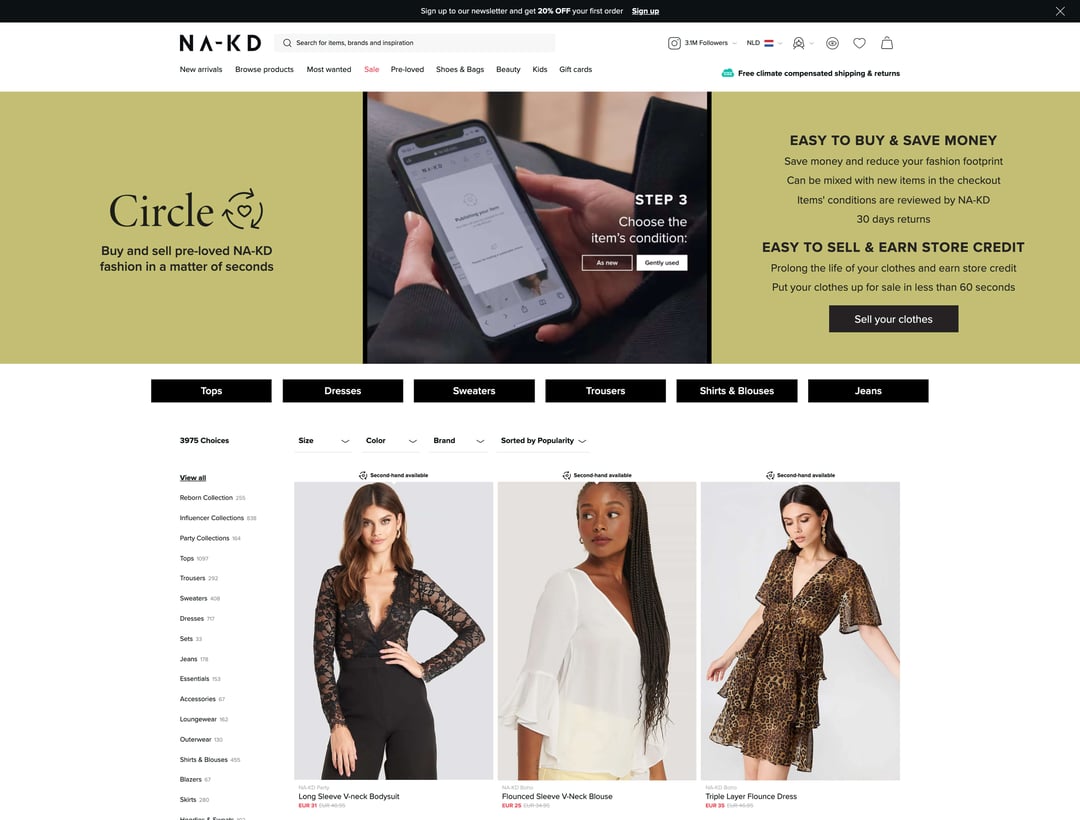
Recurate.com assists European Shopify merchants with setting up a peer-to-peer resale environment in their Shopify store. For example, they offer brands the opportunity to resell their customers’ items. How does that work, you ask? A customer logs into her account and pulls up her order history. There, she’ll find a button to sell the purchased item. After all the information, such as the condition of the product, the suggested retail price and maybe some pictures, has been uploaded, the brand receives a notification of the registration and the product can go live. The great thing about this is that Recurate has a full integration with Shopify. This way, the customer can pay for both a “pre-loved” and a new product.
In this case, resale ensures a returning customer you can build a long-term relationship with.
2. Own or existing platform
Another thing you can do is offer your resale products on your existing ecommerce environment, like NA-KD does, or set up a separate ecommerce platform, like Axel Arigato and Patagonia. Using a separate ecommerce environment also allows you to set up targeted marketing activities around this product / customer group, and to only use the data you collect there for resale purposes.
A multi-store setup on Shopify Plus gives you the possibility to open 9 extra stores and could be the way to go!
3. Buy-Back:
Buy-Back is a model in which you or a third party buys back the second-hand product directly from the customer. This allows for a bigger margin when selling a product and/or rewarding a customer’s store credit directly. This encourages them to buy something new. The downside is that you are taking a risk on the bought-back item, since you don’t know whether or not you’re going to sell it again.
You can handle the whole buying-and-selling process yourself or you can choose a partner that takes care of it for you.
If you’re going to take on the whole process (of buying back, cleaning, repairing and shipping) yourself, it may require a larger investment, but in return you’ll have more control over the process. If your growth expectations are met, this can easily turn out to be a very lucrative revenue stream. It also impacts your brand and customer experiences. To keep this in-house can prove very valuable; it’s (a lot) more expensive and difficult to attract new clients than it is to retain old ones. Resale fits into this perfectly and creates a long-term relationship with your customers.
Take Patagonia, for instance. They ingeniously combined the loyalty programs of both platforms, meaning that their customers can exchange their loyalty credits on both platforms, as well.
Patagonia & Trove (a circular powerhouse)
Patagonia has its own online-shop environment with resale products, but has completely outsourced the back office to Trove. Trove buys back the products, takes care of the repairs and cleaning, takes new photographs and takes care of the fulfillment. Consumers receive store credit for their item and can use that to purchase a new or second-hand product. This way, Patagonia ensures that the money - very cleverly and sustainably - remains within the company.
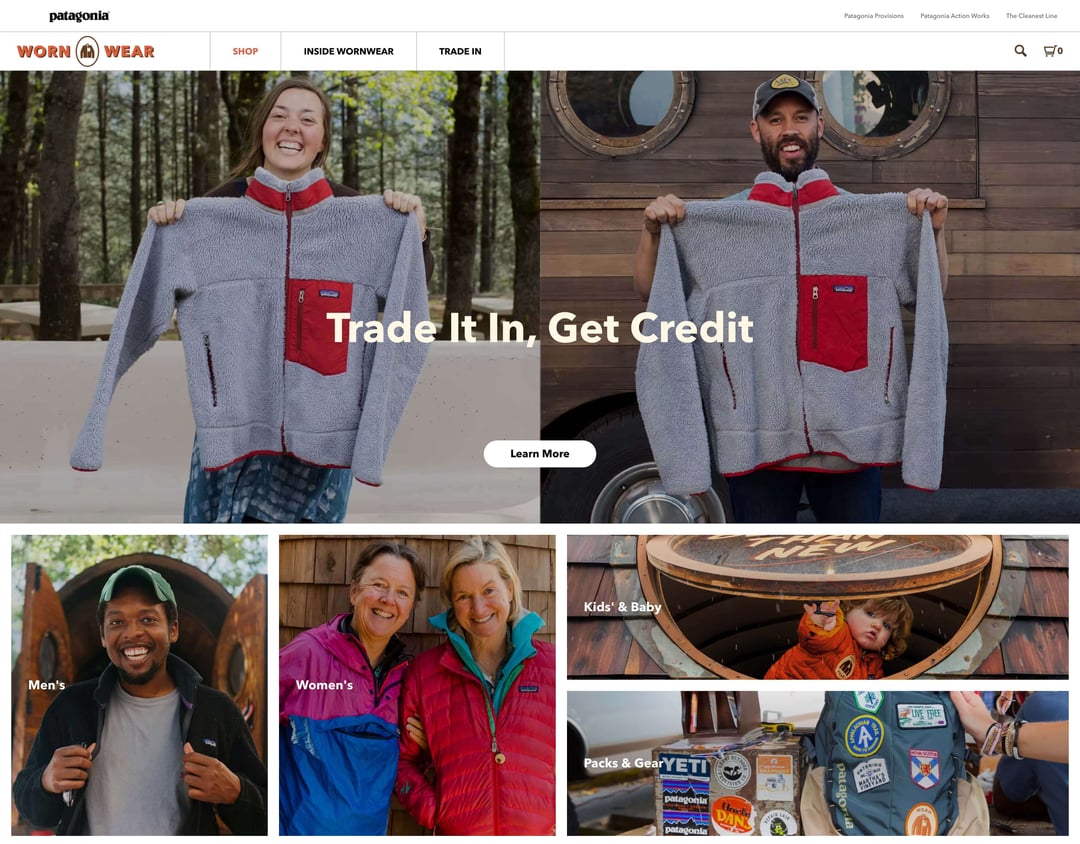
Shopify solution:
You can set up a separate store for your resale items. It’s also possible to register and link store credit, a voucher from the Shopify backend and/or loyalty credits to your users, using LoyaltyLion or Smile, for example. As far as we know, there’s no European party yet that can take care of the collection, repair and cleaning of goods, as well as the fulfillment afterwards. Code contacted Trove and they let us know that they’re looking into expanding to Europe in 2023. Something to look forward to!
4. Consignment
Consignment operates almost the same as the buy-back business model. The difference is that with consignment you only settle the final payment when the buyer has paid and the seller has approved the sale. This means you don’t have to pre-finance the products. The drawback is that your margin is lower and you don’t have the option to directly reward the seller their store credit. This means you’ll have to wait until after the sale for the seller to use her store credit. A trail-blazing company that facilitates peer-to-peer, consignment and buy-back solutions for major brands is Reflaunt.
Reflaunt.com provides software to quickly get your resale business model up and running. They also offer a full Shopify integration. An additional advantage is that Reflaunt works with (25+) resale marketplaces (including Farfetch and Net-a-Porter) and can sell your products there. What a great opportunity to introduce your brand to new customers! Reflaunt offers all three business models, and aims to completely unburden brands when it comes to resale. For peer-to-peer, consignment (they have their own warehouses in London, Paris and New York) and buy-back business models.
Summary
The resale train has left the station and is not stopping anytime soon. This is a good time to determine if and how you want to make resale part of your sustainability strategy. Particularly Gen Z prefers resale products.
There are more and more software and platforms emerging that make it easier to offer resale and to turn it into an actual business model. It provides opportunities to develop a more meaningful relationship with your customers, and an additional moment to connect with them, to provide them with a service and an opportunity to earn store credit that they can then spend at your store again.
Would you like to find out what Code can do for you when it comes to the resale options for your brand? Or do you have examples of Dutch companies that are already successfully integrated resale? Or maybe there’s something else you want to share? Please get in touch!
